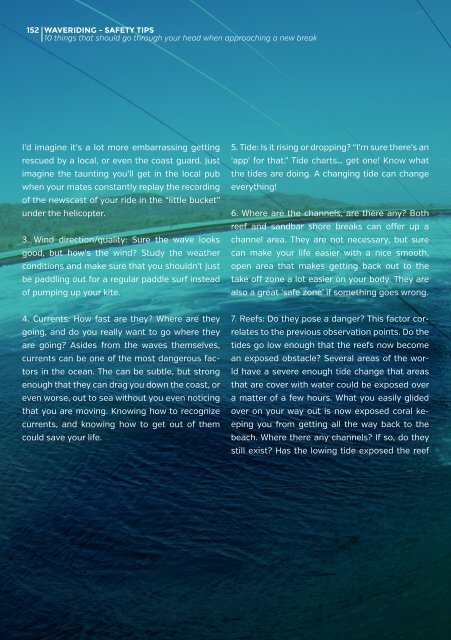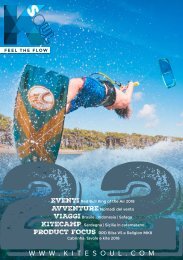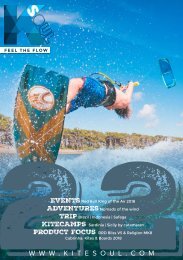Kitesoul Magazine #10 English Edition
Riders columns: Colleen Carroll, Jasse Richman; Events: World Snowkite Contest preview, Blue Palawan Open; ITW: Liam Whaley; Story: Patri MacLaughlin; Trip: Mozambico, Artic Adventure;Tech: Harnesses, Fins; Tutorial: Freestyle moves, Foiloboard, Wave.
Riders columns: Colleen Carroll, Jasse Richman; Events: World Snowkite Contest preview, Blue Palawan Open; ITW: Liam Whaley; Story: Patri MacLaughlin; Trip: Mozambico, Artic Adventure;Tech: Harnesses, Fins; Tutorial: Freestyle moves, Foiloboard, Wave.
You also want an ePaper? Increase the reach of your titles
YUMPU automatically turns print PDFs into web optimized ePapers that Google loves.
152<br />
WAVERIDING - SAFETY TIPS<br />
10 things that should go through your head when approaching a new break<br />
I’d imagine it’s a lot more embarrassing getting<br />
rescued by a local, or even the coast guard. Just<br />
imagine the taunting you’ll get in the local pub<br />
when your mates constantly replay the recording<br />
of the newscast of your ride in the “little bucket”<br />
under the helicopter.<br />
3. Wind direction/quality: Sure the wave looks<br />
good, but how’s the wind? Study the weather<br />
conditions and make sure that you shouldn’t just<br />
be paddling out for a regular paddle surf instead<br />
of pumping up your kite.<br />
5. Tide: Is it rising or dropping? “I’m sure there’s an<br />
‘app’ for that.” Tide charts… get one! Know what<br />
the tides are doing. A changing tide can change<br />
everything!<br />
6. Where are the channels, are there any? Both<br />
reef and sandbar shore breaks can offer up a<br />
channel area. They are not necessary, but sure<br />
can make your life easier with a nice smooth,<br />
open area that makes getting back out to the<br />
take off zone a lot easier on your body. They are<br />
also a great ‘safe zone’ if something goes wrong.<br />
4. Currents: How fast are they? Where are they<br />
going, and do you really want to go where they<br />
are going? Asides from the waves themselves,<br />
currents can be one of the most dangerous factors<br />
in the ocean. The can be subtle, but strong<br />
enough that they can drag you down the coast, or<br />
even worse, out to sea without you even noticing<br />
that you are moving. Knowing how to recognize<br />
currents, and knowing how to get out of them<br />
could save your life.<br />
7. Reefs: Do they pose a danger? This factor correlates<br />
to the previous observation points. Do the<br />
tides go low enough that the reefs now become<br />
an exposed obstacle? Several areas of the world<br />
have a severe enough tide change that areas<br />
that are cover with water could be exposed over<br />
a matter of a few hours. What you easily glided<br />
over on your way out is now exposed coral keeping<br />
you from getting all the way back to the<br />
beach. Where there any channels? If so, do they<br />
still exist? Has the lowing tide exposed the reef


















